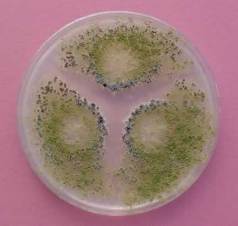Nutrition
All fungi are heterotrophs, which means that they are “other feeding”. In other words they obtain energy and organic molecules by ingesting other organisms and can not produce these themselves. Aspergillus flavus is both a saprophyte and a parasite. As a saprophyte it obtains non-living organic material but as a parasite it uses organic material from living organisms, harming them in some way. If you're interested in learning about more parasites check out some of these organisms: human lice, Taenia solium, deer ticks, and mosquitoes.
 Being heterotrophic is one characteristic that fungi share with
humans. When it gets down to the nitty gritty however, there is a
big difference between the way that they accomplish this and the way
that we do. As
humans, we ingest our food prior to digestion. Fungi though, do not
play by these rules. First they secrete exoenzymes to digest their
meal and then absorb material using structures called hyphae.
The densely branched network of hyphae is called mycelium. Mycelium
grows rapidly as proteins and other materials synthesized by the
fungus are channeled through cytoplasmic streaming to the tips of
the extended hyphae. Fungi concentrate energy and resources on
adding hyphal length to increase surface area making feeding more
efficient. Fungi
are non-vascular so they do not have transport tissues for obtained
nutrients. Another characteristic that all fungi share with humans
is that they store their food in the form of glycogen. Most
people don't realize how much in common we have with the fungi.
Being heterotrophic is one characteristic that fungi share with
humans. When it gets down to the nitty gritty however, there is a
big difference between the way that they accomplish this and the way
that we do. As
humans, we ingest our food prior to digestion. Fungi though, do not
play by these rules. First they secrete exoenzymes to digest their
meal and then absorb material using structures called hyphae.
The densely branched network of hyphae is called mycelium. Mycelium
grows rapidly as proteins and other materials synthesized by the
fungus are channeled through cytoplasmic streaming to the tips of
the extended hyphae. Fungi concentrate energy and resources on
adding hyphal length to increase surface area making feeding more
efficient. Fungi
are non-vascular so they do not have transport tissues for obtained
nutrients. Another characteristic that all fungi share with humans
is that they store their food in the form of glycogen. Most
people don't realize how much in common we have with the fungi.
Continue on to the next page if you're interested in this organism's reproduction!



